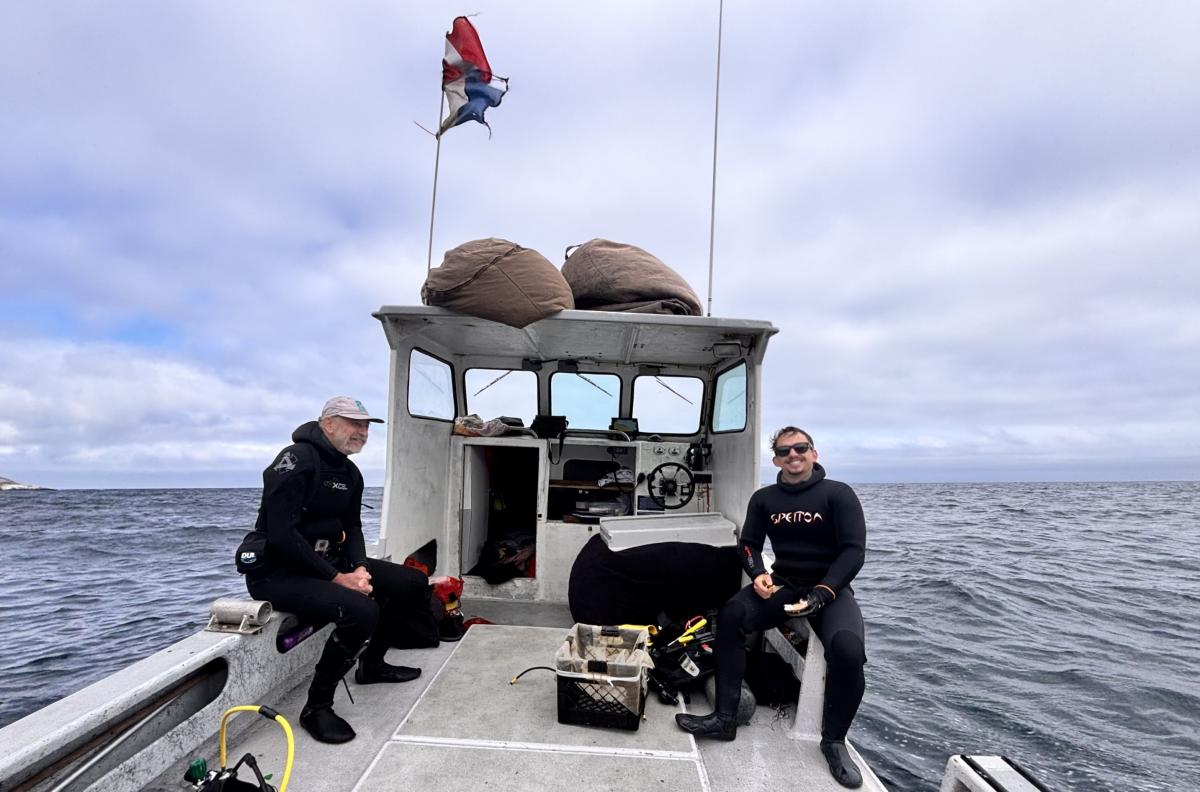
Volunteer taxonomist Gustav Pauly from the Florida Museum of Natural History, left and SBC-LTER lab technician Darrin Ambat on a morning dive to retrieve Autonomous Reef Monitoring Structures from the sea floor. Courtesy Image
The Santa Barbara Channel, where cold northern currents meet warmer southern waters, is a hotspot for marine biodiversity. While whales, fish, and sea lions are common sights, much of the region’s rich underwater life remains hidden — especially the tiny creatures living on the ocean floor.
A recent “bioblitz” led by UC Santa Barbara researchers set out to uncover this hidden world. For one week, scientists and taxonomists from across the country joined forces with UCSB students to collect and identify as many seafloor species as possible. The effort focused on cryptic invertebrates — sponges, worms, mollusks, sea stars, and other small organisms — that are essential to the health of the marine ecosystem but often overlooked.
“There’s a hidden biodiversity in our reefs,” said Bob Miller, a marine ecologist at UCSB’s Marine Science Institute and director of the Santa Barbara Coastal Long Term Ecological Research (SBC LTER) program. “These species play key roles as water filterers, decomposers, and food for larger animals.”
There’s a hidden biodiversity in our reefs — the great number of small species we generally overlook.

Members of the bioblitz team get a sense of the terrain off the coast at UCSB's Dangermond Preserve. Courtesy Image
Miller and fellow Marine Science Institute researcher Mark Page oversaw the project, while doctoral student Skylah Reis, a member of the Miller Lab, coordinated the field and lab work. Reis is using the collected data as part of her dissertation, which explores how environmental changes affect biodiversity on both natural and artificial reefs.

The Autonomous Reef Monitoring Structures are made of PVC plates to be colonized by sea life and collected for identification. Photo Credit: Sonia Fernandez
To find these elusive species, the team retrieved Autonomous Reef Monitoring Structures (ARMS) — stacks of PVC plates that had been deployed on reefs in the channel to allow marine life to colonize them. These small structures, along with samples from nearby seafloor habitats, were brought back to UCSB’s labs for careful analysis.
Researchers sorted through the collected material, separating living organisms from debris. Each specimen was given to a taxonomist with expertise in that group — whether worms, clams, bryozoans, or others — for identification. The organisms were photographed, cataloged, and prepared for genetic sequencing by collaborators at the Smithsonian Institution.
The timing of the bioblitz is important, as ocean conditions continue to change rapidly due to climate events like the 2014–2016 marine heatwave known as “the Blob.” Warmer waters stress local species and allow more heat-tolerant species to move in, shifting the region’s ecological balance. According to Reis, building a clear baseline of current biodiversity will help scientists monitor these changes more effectively.

A brittle star, bryrozoan colony and anemone share the sea floor in the Santa Barbara Channel.
“We sampled across a range of conditions — different temperatures, runoff levels, and degrees of marine protection,” said Reis. “This gives us insight into how environmental gradients shape biodiversity, especially for species that often go unnoticed.”
The bioblitz not only adds to our understanding of life in the Santa Barbara Channel, but also supports ongoing conservation work. Results will feed into national species databases and help inform decisions about marine protected areas.

Coordinated by UCSB graduate student researcher Sklyah Reis, bottom, the bioblitz team spent a week collecting and classifying the seafloor creatures of the Santa Barbara Channel. Courtesy Image
“I don’t know yet if we’ve discovered any new species,” said UCSB marine biologist and participant Thomas Turner, “but I’m certain there are more out there to be found.”
The project was supported by the Channel Islands National Marine Sanctuary, NASA, NOAA, the Bureau of Ocean Energy Management, and the Southern California Bight Marine Biodiversity Observation Network.
Adapted from original reporting by Sonia Fernandez, “Bioblitz reveals hidden biodiversity in the Santa Barbara Channel,” The Current, UC Santa Barbara, 2025.